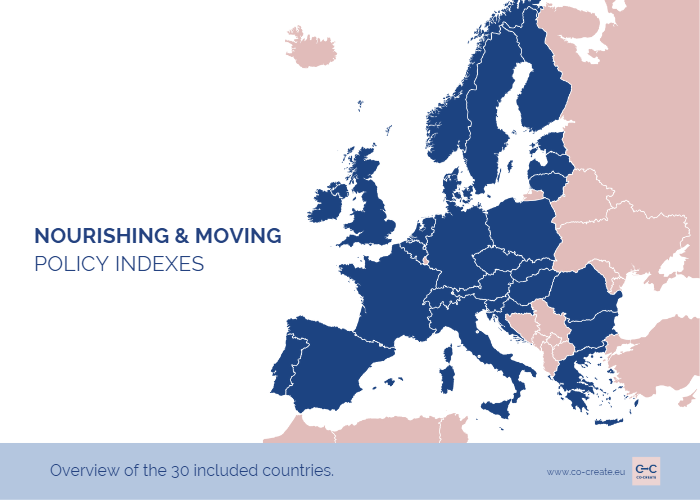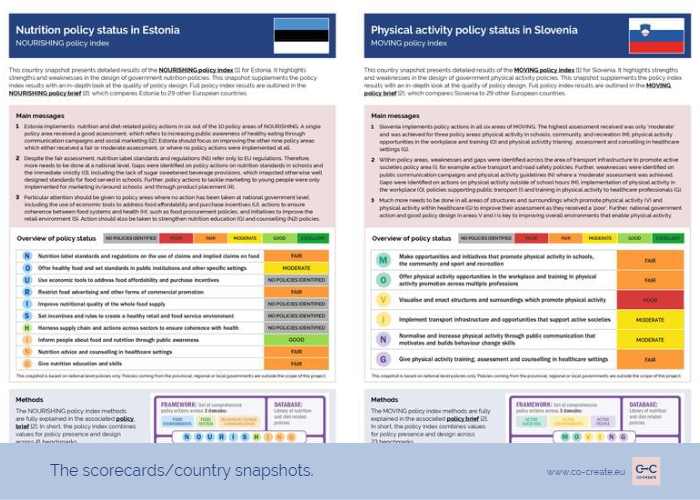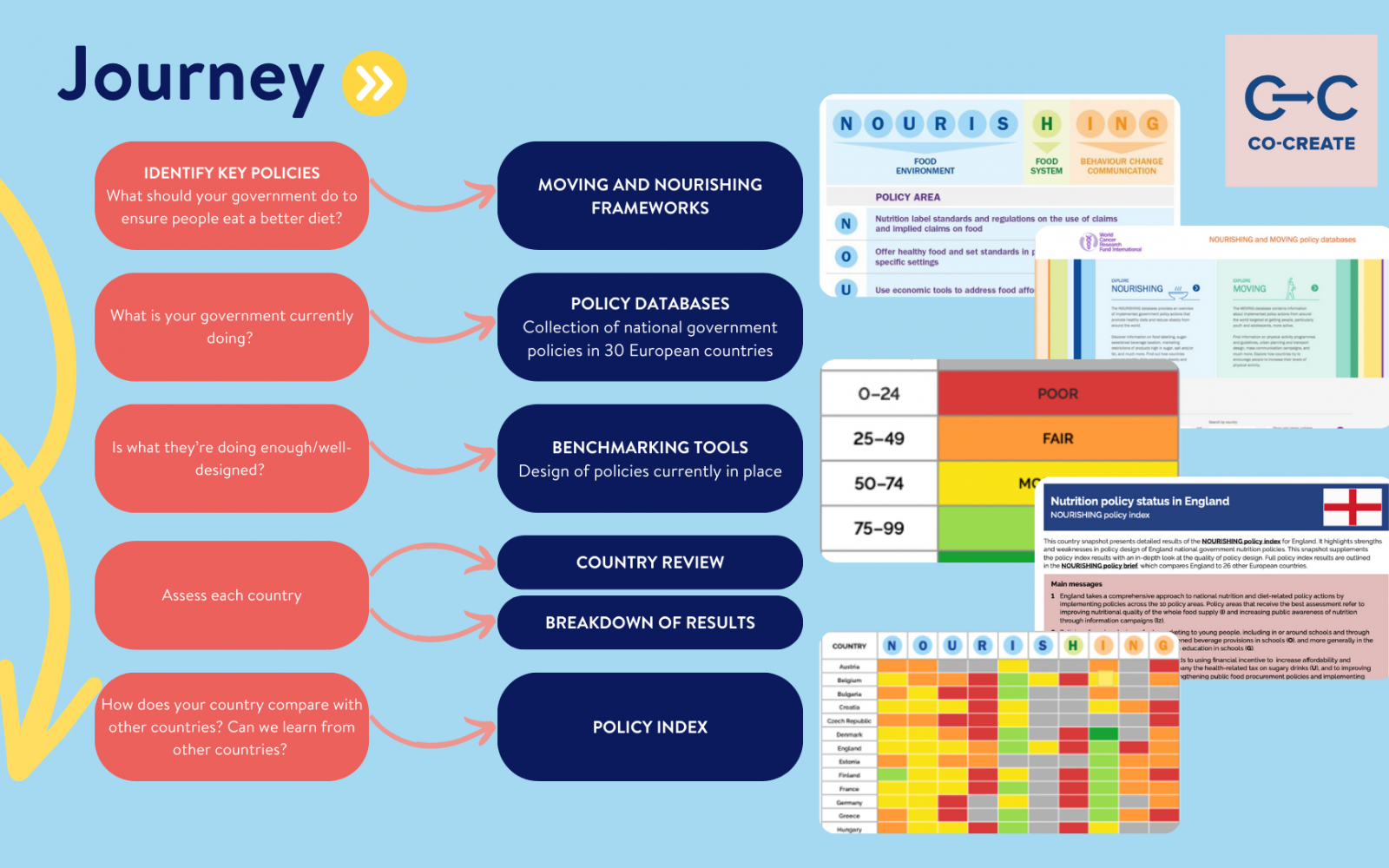Nutrition and Physical Activity Policy Tools
The NOURISHING and MOVING policy indexes.
The NOURISHING and MOVING policy indexes are tools developed as part of the CO-CREATE project by World Cancer Research Fund International.
The tools provide an assessment of how well (or poorly) national European governments are doing in nutrition and physical activity policies to create healthier environments that support us in eating a healthy diet and being physically active. The tools were developed with the goal of supporting young people in engaging with the policies that affect them.
The “Confronting Obesity: Co-creating policy with youth” project – known as ‘CO-CREATE’ - is an innovative EU-funded project that aims to reduce childhood obesity by working with young people to create policy actions promoting healthier environments. It brings together research and advocacy organisations in Europe and beyond to work with young people to create, inform and disseminate evidence-based policies that help prevent obesity. As part of this project, World Cancer Research Fund International, in partnership with the Norwegian Institute of Public Health, developed and tested the CO-CREATE tools on Nutrition & Physical Activity Policy.

What are the NOURISHING and MOVING policy indexes?
The two policy indexes give an at-a-glance assessment of how well countries in Europe are doing with regards to creating environments that enable people to eat a healthy diet and be physically active.
The NOURISHING and MOVING policy indexes place countries in different categories (from poor to excellent) for key recommended policies (for example, unhealthy food marketing, or walking and cycling infrastructure).
The results are presented in two easy-to-read policy briefs:
- NOURISHING policy brief: Nutrition policy status in 30 European countries.
- MOVING policy brief: Physical activity policy status in 30 European countries.
What do the indexes tell us?
-
The indexes show us the national policy status on nutrition and physical activity policy across 30 European countries.
-
The indexes tell us where countries are taking the most policy action and where action is insufficient across Europe.
-
Importantly, the indexes tell us whether the policies currently in place are well-designed or not.

What are Country Snapshots?
What the country snapshots tell us
- The country snapshots take a closer look at the situation in each the 30 European countries included in the index.
- For each country, they tell us how well (or poorly) the national government is doing to promote healthy diets and to encourage people to be more physically active.
- The country snapshots show specific strengths and weaknesses of the nutrition and physical activity policies currently in place in each country.
Who are the end users?
The tools can be used by a range of stakeholders to improve national and regional nutrition and physical activity policies.
- Youth groups
- Civil society
- Policymakers
- Researchers

How can the tools be used by other key user groups?
- Civil society can identify weaknesses in the policy status. These weaknesses can inform advocacy efforts to improve the policy environments impact the current and future rates of overweight and obesity.
- Policymakers can utilise the policy design criteria to improve current policies, identify gaps at national levels, and identify opportunities for action at local and regional level.
- Researchers can compare high-scoring and lower-scoring countries to identify how existing policies can be improved to meet aspirational standards and identify where results could be supplemented by additional analyses at local level and in specific settings.

How can youth use the indexes for advocacy?
How can youth use the Country Snapshots for advocacy?
- You can learn how well (or poorly) your country is doing in nutrition and physical activity policy at national level.
- You can learn what the policy status is in Europe and compare your country with other European countries.
- You can identify weaknesses in the policy status that can inform advocacy efforts to improve the policy environments, either in your country, or across Europe.

Links to Indexes, Briefs & Country Snapshots
- NOURISHING policy index page
- NOURISHING policy brief
- NOURISHING country snapshots
- MOVING policy index page
- MOVING policy brief
- MOVING country snapshots
FAQs
The MOVING and NOURISHING policy indexes rate countries’ ‘policy status’ in the area of physical activity and nutrition policy. They combine a large amount of information in a single assessment of the status of each policy area of the NOURISHING and MOVING policy frameworks. Results are displayed by country and policy area of each framework. Thus, the indexes allow easy comparisons between countries.
The tools are innovative in that they offer an easy-to-use, objective assessment of implemented policies, based on criteria that are aspirational.
The policy indexes were produced by applying so-called benchmarking tools to policies collected in our NOURISHING and MOVING policy databases. The benchmarking tool holds governments accountable to a higher, aspirational standard rather than comparisons to current best practices. The full criteria are available here.
Aspirational criteria, which were informed by scientific research and expert consultation, hold countries to a higher standard. This is necessary, because current national government efforts to tackle preventable non-communicable diseases and overweight and obesity have proven insufficient.
The policy index is one of a set of policy tools developed as part of the CO-CREATE project to monitor, benchmark and compare national government nutrition policies . The NOURISHING and MOVING policy indexes are structured around the NOURISHING and MOVING frameworks and developed by applying the NOURISHING and MOVING benchmarking tool.
Each benchmarking tool includes a set of benchmarks (and associated indicators) across the policy areas of the NOURISHING and MOVING frameworks. The indicators are measured by two types of attributes: a) one attribute for the existence of a policy action, and b) an associated set of policy attributes to assess the design of the policy actions.
The final results are calculated in two stages:
- Benchmark scores (0–100) = Policy action presence (“no” = 0, “yes” = 50) + Average of design attributes scores (0–50)
- Policy area scores (0–100) = Calculated average (mean) of benchmark scores for each policy area
Austria, Belgium, Bulgaria, Croatia, Czech Republic, Denmark, Estonia, Finland, France, Germany, Greece, Hungary, Ireland, Italy, Latvia, Lithuania, Malta, Netherlands, Norway, Poland, Portugal, Romania, Slovakia, Slovenia, Spain, Sweden, UK (England, Northern Ireland, Scotland and Wales).
There are currently no planned updates of the policy brief or the country snapshots. The results presented in the policy brief reflects our knowledge as of May 2023. However, we know that the policy landscape is always changing. As we become aware of new policy developments in the future, we will consider whether the policy briefs or the country snapshots should be updated. To enquire about updates, please get in touch at policy@wcrf.org.
The policy index results are reflective of the current policy status of nutrition and physical activity as of May 2023.
